 Weed Grow Guide by Royal Queen Seeds
Weed Grow Guide by Royal Queen Seeds
- Growing weed step by step
- Marijuana growing basics
- Choosing your seeds
- How to germinate seeds
- The marijuana vegetative stage
- The marijuana flowering stage
- Harvesting marijuana
- Trimming, drying, and curing
- Choosing pots and soil
-
Growing indoors
- A Complete Overview Of Growing Cannabis Indoors
- Cannabis Cultivation Tips: How To Set Up Indoor Grow Lights
- How Many Cannabis Plants Can You Grow Per Square Metre?
- Indoor Cannabis Growing: Relative Humidity and Temperatures
- Hydroponics Cannabis Growing Guide (with diagrams)
- Cannabis Micro Growing: Growing Great Weed in Tiny Spaces
- Growing outdoors
- How to grow autoflowering marijuana
- Marijuana nutrients and pH
- Marijuana troubleshooting: Nutrients
-
Marijuana troubleshooting: Growing
- Cannabis Seed Germination — Troubleshooting Guide
- How to Deal With Pythium (Root Rot) in Cannabis Plants
- Slow Cannabis Plant Growth And What You Can Do About It
- How to Prevent and Fix Stretching in Cannabis Seedlings
- Watering Your Cannabis: How to Fix Overwatering and Underwatering
- Understanding Male, Female, And Hermaphrodite Cannabis
- Identifying and Treating Common Cannabis Ailments
- How To Revive a Sick Cannabis Plant
- How to Avoid Moldy Marijuana During Drying and Curing
- How to Prevent and Treat Dry and Crispy Cannabis Leaves
- What Cannabis Leaves Can Tell You
- Causes and Solutions for Yellow Cannabis Leaves
-
Marijuana Strains Grow Report
- HulkBerry Automatic Grow Report
- Blue Cheese Auto Grow Report
- Purple Punch Automatic Grow Report
- Triple G Automatic Grow Report
- Do-Si-Dos Automatic Grow Report
- Green Gelato Automatic Grow Report
- Haze Berry Automatic Grow Report
- Purple Queen Automatic Grow Report
- Cookies Gelato Automatic Grow Report
- Sherbet Queen Automatic Grow Report
- Sweet Skunk Automatic Grow Report
- Medusa F1 Grow Report
- Marijuana plant training
-
Marijuana growing tips
- The Cannabis Plant Anatomy
- How to preserve seeds
- How Much Sunlight Do Outdoor Cannabis Plants Need To Grow?
- How to Control and Prevent Stretching in Cannabis Plants
- My Cannabis Plants Are Growing Too Tall: What Should I Do?
- Should You Worry About Purple Or Red Cannabis Stems?
- What To Do When Your Indoor Cannabis Won’t Flower
- How To Protect Your Cannabis Plants From Heat Stress
- How To Tell If Your Female Cannabis Plant Has Been Pollinated
- Growing Medical Marijuana
- Bud Washing: How to Clean Your Weed
- Understanding Cannabis Yield per Plant

Mastering The Cannabis Seedling Stage In Just 3 Steps
Three simple steps to mastering the cannabis seedling stage.
Contents:
- Step 1: pick the right genetics, containers, and medium for your seedlings
- Step 2: use the right germination techniques
- Step 3: mastering the seedling stage
- How to water your cannabis seedlings
- How to prevent damping off
- How to avoid nutrient problems
- How to prevent pests and bugs
- How to prevent stretchy seedlings
- Know when and how to transplant your seedlings
- Bonus step: understanding the seedling stage
- Get growing!
Cannabis seedlings can be tricky to keep alive, especially for rookie growers. With a solid understanding of seedlings and their requirements, though, the all-important seedling stage can be a lot less threatening. Keep readingfor three simple steps to growing healthy seedlings.
Step 1: Pick the Right Genetics, Containers, and Medium for Your Seedlings
When sourcing your seeds, be sure to actively search out the right strain for you; your experience and skill as a grower, budget, grow equipment, preferences in taste and effect, and whether you’re growing indoors or outdoors will determine which strain will yield the best results for you.
As for the medium,
we always recommend growing in a light, well-aerated, slightly acidic soil with a pH of 6.3–6.5. We recommend using between 20–50% perlite in your medium to aid with soil aeration and nutrient retention. The more nutrients you plan to give your plants, the more perlite you should add to your soil to help with drainage and prevent nutrient lockout.
Remember to water just around the stem of your seedlings, and only once the soil has completely dried out (see the section on over/underwatering below for more info). Also, keep in mind that seedlings (especially autoflowering varieties) are extremely sensitive to nutrients. Never plant them into hot (nutrient-rich) soil and don’t start feeding them until they’ve grown 3–4 sets of true leaves.
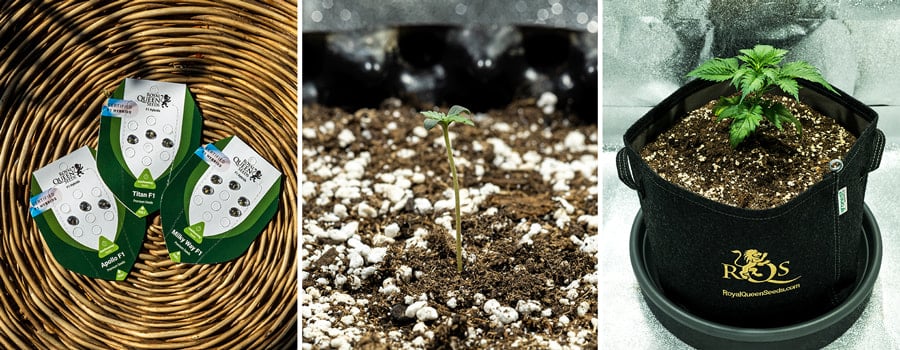
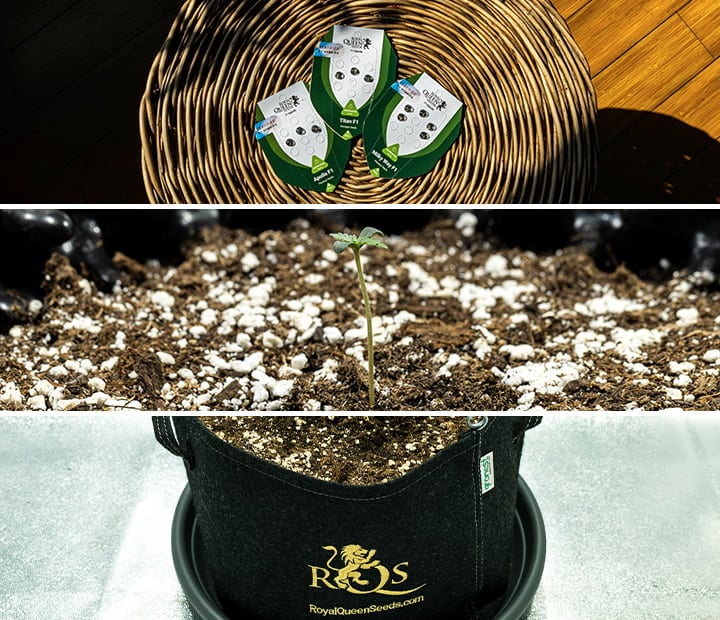
When it comes to picking pots, we recommend the following approaches for autoflowering and feminized seedlings.
The Right Pots for Autoflowering Cannabis Seeds
When growing autoflowers, we recommend planting them directly in their final pots. Because of their short life cycle, it’s best to avoid putting autoflowering strains through any kind of unnecessary stress, including transplanting. While the exact pot size you use will vary depending on the strain you’re growing and the size of your grow space, most auto growers use pots between 5–15l.
The Right Pots for Feminized Cannabis Seeds
If you’re growing feminized seeds, transplanting isn’t as much of an issue since these plants have time to recover from the stress. Using Easy Start germination pots, you can support robust health right from the beginning. You’ll want to transplant your seedlings just before they start outgrowing their starter pots. We typically recommend transplanting once they’ve grown sets of true leaves that spread out to cover the full circumference of their current container.
From here, most indoor growers move their plants directly into 12l pots, but you can go above or below that to suit your particular strain and grow setup. Keep in mind that you can (and should) up-pot feminized photoperiod plants a few times to max-out development, meaning you don’t need to transplant your seedlings into a giant pot right away.
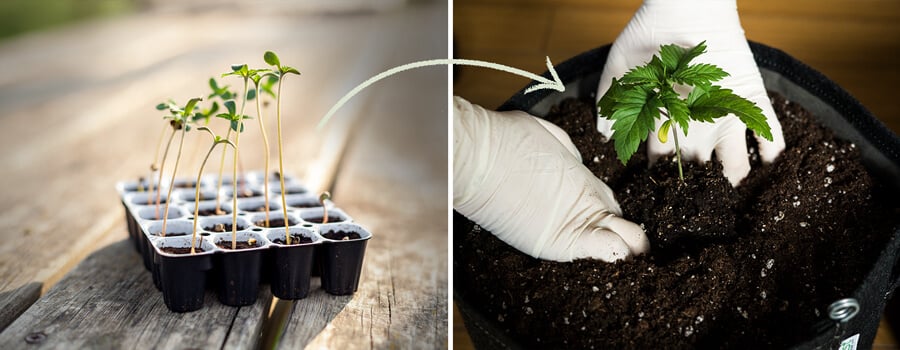
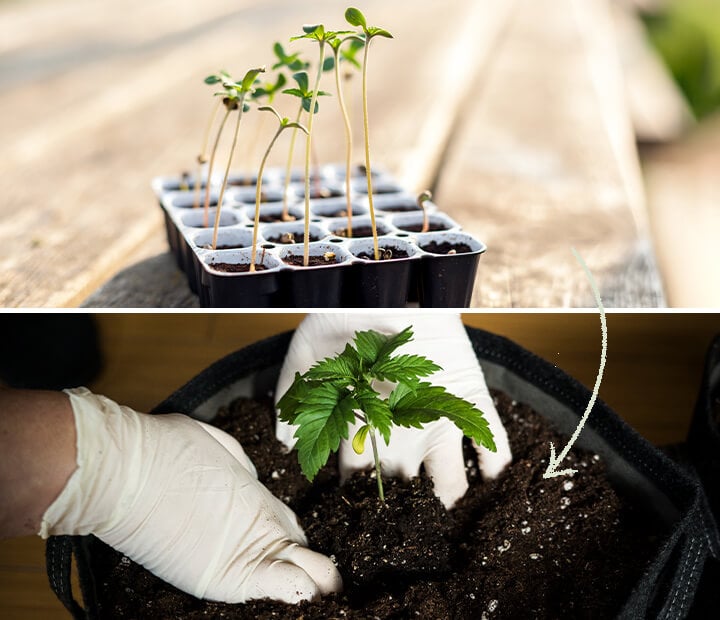
A Note on Cannabis Pots
From cheap nursery containers to sophisticated smart pots, growers are spoilt for choice when it comes to picking the right container for their cannabis plants. And while it’s possible to grow great weed in cheap plastic propagation containers, there are a couple of things you’ll want to keep in mind when choosing pots for your weed plants.
1. Drainage holes
Make sure your pots drain well to protect your plants against fungal pathogens and root rot. If your pots don't already contain holes (or some other kind of mesh to allow runoff), you'll need to puncture them yourself.
2. Aeration
One of the functions of a plant's substrate is to serve as a site for air exchange between the roots and the environment. Smart pots like the RQS Fabric Pot help your plant’s roots respire by allowing more oxygen to reach them. This translates into faster, more vigorous growth, healthier plants, and a better harvest.
3. Pot size
Keeping tiny seedlings in huge pots increases the risk of overwatering, as your plant’s roots won’t be big enough to extract all the water from their substrate. Any water that stays in the substrate will effectively drown the roots and attract pathogens and pests into your garden/grow room.
Step 2: Use the Right Germination Techniques
Cannabis seeds need four things in order to germinate: moisture, warmth, darkness, and time. To ensure you grow healthy seedlings, germinate your seeds using one of the following techniques.
Paper towel method
Carefully place your cannabis seeds between a few moist pieces of paper towel, and place it all in a plastic container with a lid. Keep the container in a warm, dark place (temperatures between 20–25°C are ideal). Leave a slight crack in the lid to allow for some fresh air exchange.
Glass of water method
Simply drop your seeds into a glass of water and let them sit in a cupboard for 24–48 hours at 20–25°C. Once you see the first signs of taproots sprouting from your seeds, they’re ready to plant. If your seeds don’t germinate after 48 hours in water, switch to the paper towel method. Don’t keep the seeds submerged for more than 48 hours or they’ll rot.
Your seeds are ready to plant once they’ve cracked open and released a small, white taproot. Plant your germinated seeds one knuckle (roughly 3–5 millimetres) deep with the taproot facing down. That way, your seedlings won’t have to reorient themselves.
RQS Starter Kits
Alternatively, use the RQS Autoflowering or Feminized Starter Kits to provide your seeds with the perfect conditions from the get-go. This kit contains starter pots filled with perlite and beneficial bacteria, as well as a propagator and lights to breathe life into your seeds.
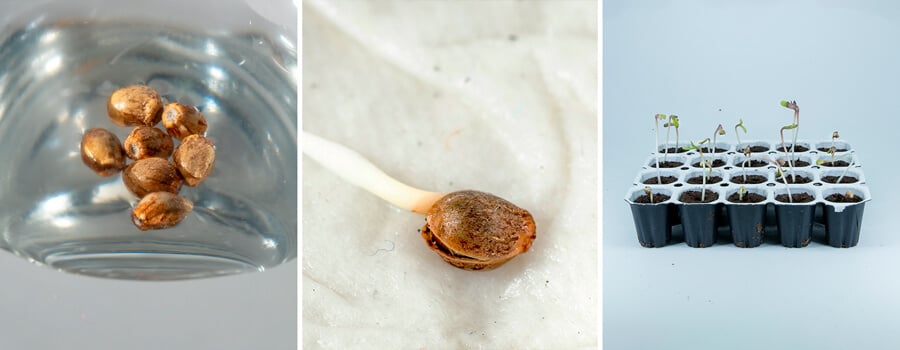
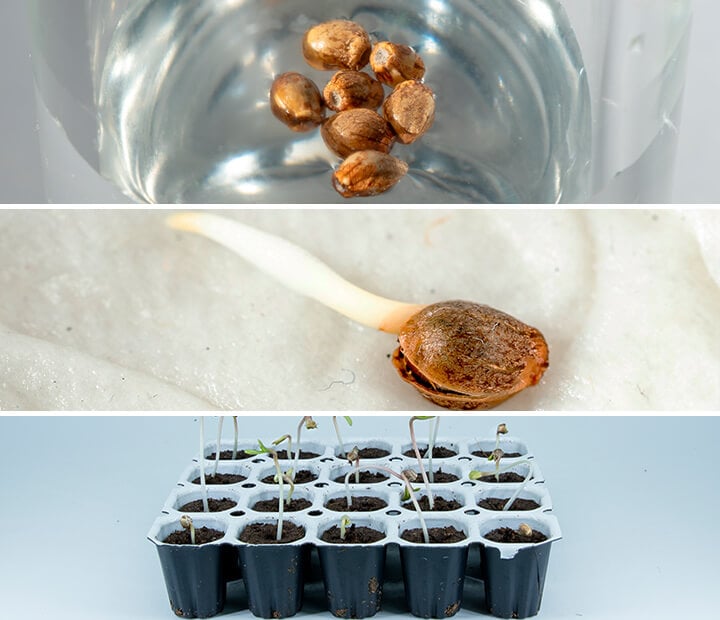
Step 3: Mastering the Seedling Stage
Now that your seedlings are in their soil, the real challenge begins. Cannabis seedlings are extremely fragile; armed with nothing but frail roots and a small set of cotyledons (that first set of small rectangular leaves), minor stressors can take down your seedlings in just a couple of hours. By taking the time to understand your seedlings and their specific needs, however, you’ll automatically know how to optimise their environment and help them grow into strong vegetative plants.
The Basics: Optimising Light, Temperature, and Humidity for Cannabis Seedlings
Seedlings have very particular needs when it comes to temperature, humidity, and lighting, and missing the mark in any of these areas can prove fatal for such small plants. For best results, we recommend growing seedlings in a propagator where you can easily create the perfect environment for them to flourish in.
Free RQS
Grow Guide!

Temperature
Cannabis seedlings like daytime temperatures of 20–25°C and nighttime temperatures that are roughly 4–5°C cooler. High temperatures will stress your seedlings and stunt their growth, which, at such an early stage, can prove fatal. Dry leaves with curled up edges are a telltale sign of heat stress. With time, your seedlings might also develop other symptoms, including pale foliage and red or purple stems. Heat stress can also cause weak, wilting leaves with downward folding tips.
Cold temperatures, on the other hand, can freeze a seedling’s cells and affect its ability to transport and use nutrients, water, and oxygen. This will result in stunted growth and eventually death if not dealt with properly. Wilting foliage, slow growth, and poor plant turgor are some signs that the temperature in your grow room or propagator is too low.
Humidity
While their roots are young and still developing, cannabis seedlings absorb water via osmosis in their leaves. To optimise this process, it’s super important to keep relative humidity levels at 65-70%.
Humidity levels below 20% will seriously stunt the growth of your seedlings and may cause them to develop symptoms similar to some nutrient deficiencies (yellow or spotted leaves). Humidity levels above 60%, on the other hand, will cause your plants to develop wet spots that can cause foliage to wilt or rot, as well as attract fungi and/or other pathogens and pests. Once your seedlings enter the vegetative phase, you should keep relative humidity at 50%.
Lights
Seedlings are sensitive to light and will burn under strong HID or LED bulbs. Like adult plants, seedlings will develop burnt, crinkled leaves when suffering from light stress. Alternatively, seedlings that don’t get enough light will grow tall and lanky and topple over.
For best results, we recommend growing your seedlings under an 18/6 light cycle using CFL bulbs with a blue light spectrum for the first 10–14 days. Once they’ve developed healthy true leaves and at least 2–3 nodes, you can move them under stronger HID or LED lights to start vegging.
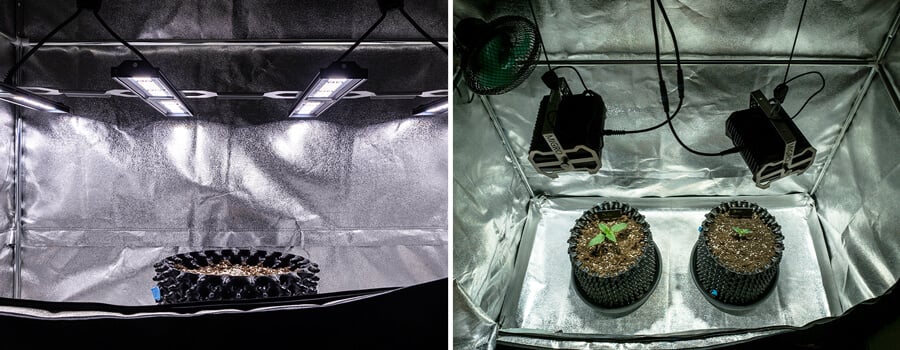
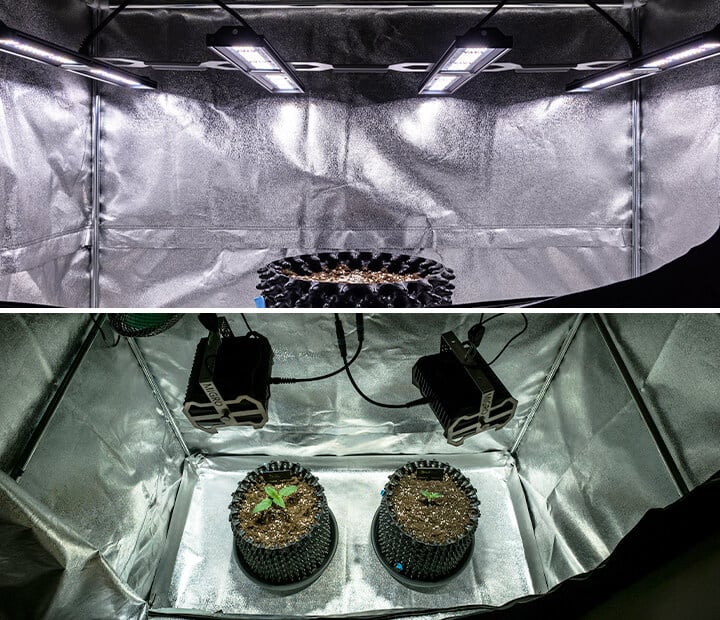
Growing Seedlings Outdoors
Outdoor growers obviously don’t have the liberty of being able to change the temperature or humidity with the push of a button. If you're an outdoor grower, you have three options on how to tackle the seedling stage:
- Most growers choose to keep their seedlings indoors under CFL lights for the first two weeks to protect them from elements.
- Alternatively, you can keep your seedlings outdoors during the day (as long as temperatures sit consistently between 20–25°C) and only move them indoors at night to protect them from the cold, rain, etc.
- Finally, you can keep your seedlings outdoors permanently in a propagator, greenhouse, or polytunnel to provide shelter and allow you to drive up humidity and manipulate the temperature.
How to Water Your Cannabis Seedlings
How often you should water your cannabis seedlings depends on a variety of factors. The best way to promote the health of your seedlings is to start them off in a high-quality, well-aerated medium. You'll want to grow them in well-draining pots (fabric pots or Air-Pots work best) and, where possible, under standard CFL lights hanging roughly 25–45cm (9–18") from the top of your pots.
The type of grow lights you use, the size of your pots, the exact composition of your soil, and the temperature and relative humidity in your grow room/garden will directly impact how often you should water. Just remember that knowing when and how much water to give each seedling will come with time and practice.
The Best Way to Water Cannabis Seedlings
Cannabis seedlings like warm and moist (but not wet) conditions. During the earliest days of their life cycle, seedlings take up water via their leaves, as their root systems are still underdeveloped.
- Mist your seedlings regularly (3–6 times a day, depending on the temperature in your grow area). Be sure to cover your seedlings with a plastic dome or bag to help trap moisture, facilitating their ability to take up moisture via their cotyledons and first true leaves.
- Do not water your seedlings directly at the stem. Instead, pour water around the plant in a circle roughly 3cm from the stem. This will promote healthy root growth, as the roots are encouraged to grow outward in search of water, and also prevents moisture buildup at the stem (which can create a breeding ground for Pythium, Botrytis, and Fusarium—fungi that cause "damping off").
When to Water Your Cannabis Seedlings
Remember—there is no universal watering schedule; how and when to water your young plants will vary depending on the factors mentioned earlier. A good rule of thumb is to only water your seedlings when their soil has dried out. You can stick your finger roughly 2cm into the soil to test whether it is dry or not.
When it's time to water your seedlings, it's best to do so early in the morning or just before you switch on your grow lights. This will allow your plant to take up water during the day as it grows. Plus, the warmth from the sun or your grow lights will also evaporate some of the water in your soil, which will help to prevent the buildup of unwanted bacteria and fungi.
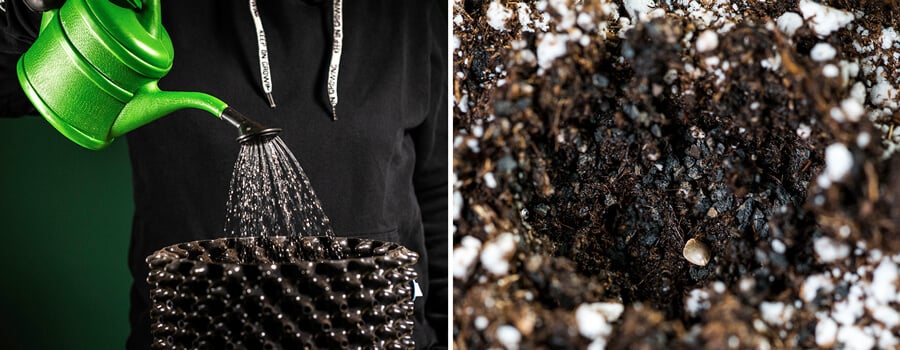
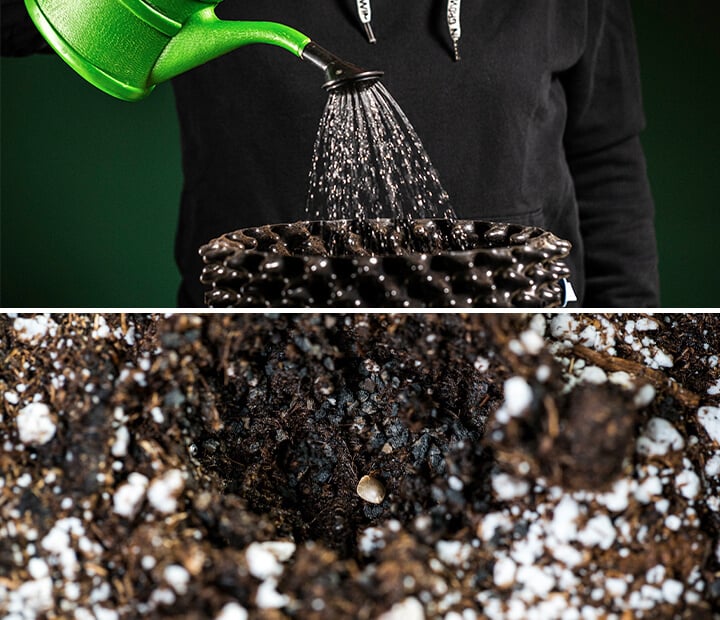
How Often Should You Water Your Cannabis Seedlings?
Water your seedlings whenever their soil is dry. This could be every 3–7 days, depending on:
- The composition of your soil and how much water it retains.
- The temperature and relative humidity in your grow space.
- The kind of lighting you are using. CFL and LED lights produce less heat than MH/HID lamps, which tend to dry out soil faster.
- The size of your pots.
- How much water you give your seedlings when you water them (see below).
How Much Water to Give Your Seedlings
Again, there is no one-size-fits-all approach to watering cannabis seedlings, and the exact amount of water you give your plants will depend on the size of their pots. In most cases, you won't need to give your seedling more than 1–2 cups of water at a time.
How to Prevent Damping Off
We’ve all been there; your seedlings look perfectly healthy, then suddenly you find them slumped over the edge of their containers. Within 24 hours (or sometimes less), they’ve shriveled up and died.
This phenomenon, known colloquially as “damping off”, is caused by fungi like Pythium, Botrytis, and Fusarium. While these fungi can lie dormant in soil, they grow and thrive in overly wet conditions. Overwatering and high humidity, for example, are some of the most common causes of damping off.
Unfortunately, by the time your seedlings show the first signs of damping off (a limp and discolored stem), there’s nothing you can do to save them. We just recommend removing the affected seedlings from your grow room or propagator ASAP to avoid spreading the fungi.
To prevent damping off, make sure to keep close tabs on the temperature and relative humidity in your grow space, and avoid overwatering your plants. Also, make sure both your soil and pots drain well.
Finally, to minimise the chance of a Pythium, Botrytis, or Fusarium infestation even further, be sure to always use new soil or sterilise your soil by baking it in the oven until it reaches a temperature of 85°C.
How to Avoid Nutrient Problems
Healthy cannabis plants look vibrant and green, and any sort of discoloration on a plant’s leaves or stems can be a sign of nutrient stress.
Remember, cannabis seeds are jam-packed with nutrients to help get your seedlings through the first stage of their life. Once these nutrients run out, it’s time for you to step in and give your plants the added nutrients they need to veg and flower properly.
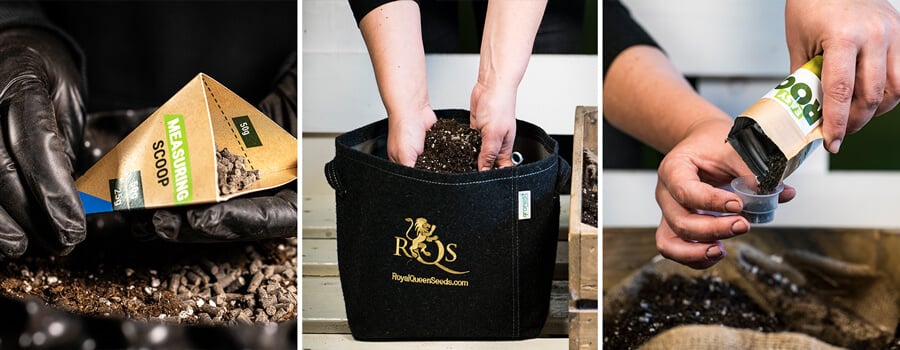
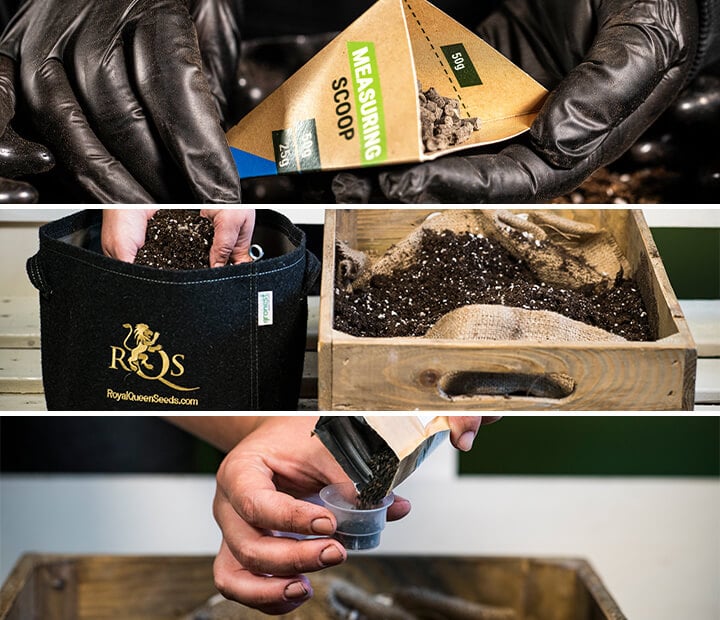
How to Prevent Pests and Bugs
Pests and plagues can destroy seedlings in less than a day. To prevent this from happening, it’s super important to keep the environment around your seedlings clean and at optimal temperatures and humidity levels. Avoid overwatering, and remember to read up on common cannabis pests so you can spot and treat them early. Some common pests to look out for include:
- Fungus gnat
These small, black, fly-like bugs feed off your plants and lay their larvae in wet topsoil. - Spider mites
Black or red in color, spider mites live on the underside of leaves and sometimes spin protective webs around healthy foliage. They love hot, dry conditions. - Leaf miners
These small, slender, winged insects leave irregular snail-trail-like spots on healthy leaves. - White powdery mildew
As the name suggests, white powdery mildew is a type of mold that forms as a white, flour-like powder on the leaves of your plants. - Pythium and Fusarium
These fungi can be hard to spot, but white spots on wet topsoil can be an early sign of their presence.
Cannabis seedlings like warm, humid conditions. Unfortunately, pests and diseases also love these conditions. Keeping things extra clean and growing your seedlings in a propagator can help prevent an infestation.
How to Prevent Stretchy Seedlings
Seedlings stretch in order to get closer to their light source. To keep your seedlings from developing unnaturally long, flimsy stalks, grow them under blue spectrum CFLs located roughly 5cm from the top of the plants. Also, avoid keeping your seedlings in the dark for 24 hours after germination (a common piece of advice on grow forums), as the lack of light will force your seedlings to stretch abnormally.
Know When and How to Transplant Your Seedlings
Unfortunately, transplanting seedlings is far from an exact science; rather than following a strict calendar or schedule, it’s all about paying attention to your plant and knowing which cues to look out for.
As we mentioned earlier, a good rule of thumb is to transplant seedlings when their leaves fully cover the circumference of their container. After about one week, try checking on your seedlings’ roots. If you can completely remove a seedling and all its soil, it is ready to transplant.
Remember to be very gentle when handling your seedlings and transplanting them. Any diminute damage to their roots can result in a ton of stress that, for such young and fragile plants, can take a while to recover from.
Bonus Step: Understanding the Seedling Stage
Inside that dark, hard shell, cannabis seeds house all the necessary genetic information to sprout and grow into big, luscious plants. When exposed to humidity and warmth, seeds are able to absorb water from their environment. This process is known as imbibition, and it’s the key to life for all plants.
Once water enters a seed, it activates special enzymes that trigger the growth of the taproot (the small white root that pops out of seeds when germinated properly). This root starts to push deeper underground in search of more water while the seed sends a shoot up and out of the soil in search of light.
Cannabis seeds already contain two cotyledons (or embryonic leaves) that unravel and push the seed casing from the shoot. After the cotyledons emerge, cannabis plants will develop their first set of true leaves. These will grow out of the main stem and have just one finger.
During the early stages of their lives, cannabis seedlings get all their energy from stores inside the seed. As their roots develop, they can absorb water via their leaves. Once your plants have developed their first sets of true leaves (that is, leaves with at least 5–7 fingers), they are no longer considered seedlings and are officially vegging.
Remember, rapid growth and vibrant green foliage are telltale signs of healthy seedlings.
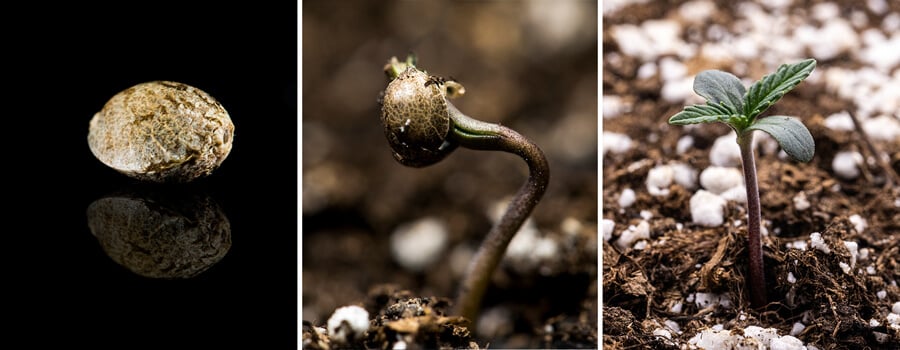
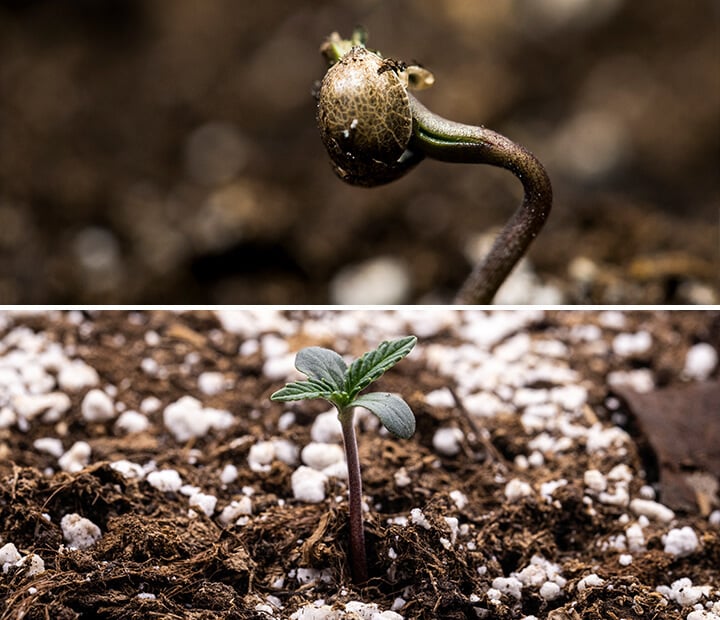
Get Growing!
Now that you know the theory behind growing healthy cannabis seedlings, it’s time to get your hands dirty. Remember to invest in one of our Starter Kits for the best, most reliable results, and keep reading our blog for more tips on growing spectacular weed at home.
 Grow Guide Topic Finder
Grow Guide Topic Finder
- Growing weed step by step
- Marijuana growing basics
- Choosing your seeds
- How to germinate seeds
- The marijuana vegetative stage
- The marijuana flowering stage
- Harvesting marijuana
- Trimming, drying, and curing
- Choosing pots and soil
-
Growing indoors
- A Complete Overview Of Growing Cannabis Indoors
- Cannabis Cultivation Tips: How To Set Up Indoor Grow Lights
- How Many Cannabis Plants Can You Grow Per Square Metre?
- Indoor Cannabis Growing: Relative Humidity and Temperatures
- Hydroponics Cannabis Growing Guide (with diagrams)
- Cannabis Micro Growing: Growing Great Weed in Tiny Spaces
- Growing outdoors
- How to grow autoflowering marijuana
- Marijuana nutrients and pH
- Marijuana troubleshooting: Nutrients
-
Marijuana troubleshooting: Growing
- Cannabis Seed Germination — Troubleshooting Guide
- How to Deal With Pythium (Root Rot) in Cannabis Plants
- Slow Cannabis Plant Growth And What You Can Do About It
- How to Prevent and Fix Stretching in Cannabis Seedlings
- Watering Your Cannabis: How to Fix Overwatering and Underwatering
- Understanding Male, Female, And Hermaphrodite Cannabis
- Identifying and Treating Common Cannabis Ailments
- How To Revive a Sick Cannabis Plant
- How to Avoid Moldy Marijuana During Drying and Curing
- How to Prevent and Treat Dry and Crispy Cannabis Leaves
- What Cannabis Leaves Can Tell You
- Causes and Solutions for Yellow Cannabis Leaves
-
Marijuana Strains Grow Report
- HulkBerry Automatic Grow Report
- Blue Cheese Auto Grow Report
- Purple Punch Automatic Grow Report
- Triple G Automatic Grow Report
- Do-Si-Dos Automatic Grow Report
- Green Gelato Automatic Grow Report
- Haze Berry Automatic Grow Report
- Purple Queen Automatic Grow Report
- Cookies Gelato Automatic Grow Report
- Sherbet Queen Automatic Grow Report
- Sweet Skunk Automatic Grow Report
- Medusa F1 Grow Report
- Marijuana plant training
-
Marijuana growing tips
- The Cannabis Plant Anatomy
- How to preserve seeds
- How Much Sunlight Do Outdoor Cannabis Plants Need To Grow?
- How to Control and Prevent Stretching in Cannabis Plants
- My Cannabis Plants Are Growing Too Tall: What Should I Do?
- Should You Worry About Purple Or Red Cannabis Stems?
- What To Do When Your Indoor Cannabis Won’t Flower
- How To Protect Your Cannabis Plants From Heat Stress
- How To Tell If Your Female Cannabis Plant Has Been Pollinated
- Growing Medical Marijuana
- Bud Washing: How to Clean Your Weed
- Understanding Cannabis Yield per Plant







































